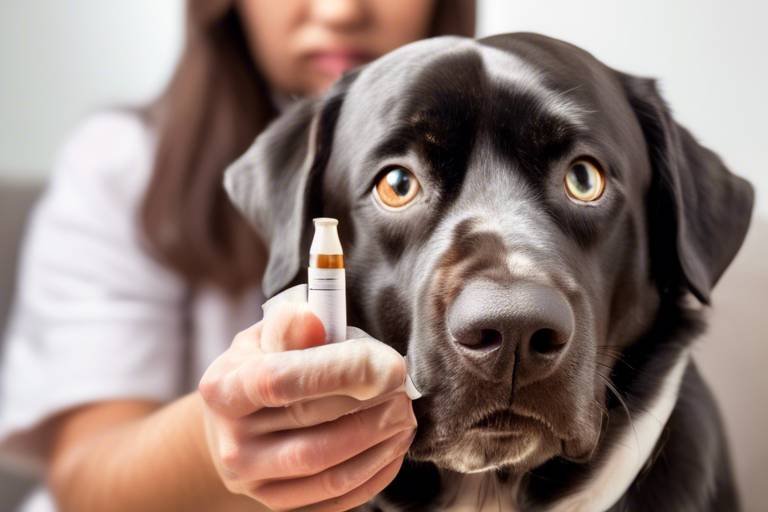The Role of Pet Insurance in Emergency Situations
When it comes to our furry companions, we all want to ensure they receive the best care possible. However, emergencies can strike at any moment, leaving pet owners feeling overwhelmed and financially strained. This is where pet insurance plays a crucial role. Imagine being faced with a sudden illness or an unexpected accident involving your pet. The last thing you want to worry about is how to pay for the veterinary bills. With the right pet insurance plan, you can have peace of mind knowing that you are financially prepared for such emergencies.
Pet insurance can be a lifesaver, providing financial relief during those critical moments when your pet needs immediate medical attention. It allows you to focus on what truly matters—your pet's health—without the added stress of potential costs. But how does pet insurance actually work in these situations? Essentially, it helps cover the costs associated with emergency veterinary care, which can often be quite steep. From diagnostic tests to surgeries, the expenses can add up quickly, sometimes reaching thousands of dollars.
To give you a clearer picture, let’s break down some typical costs associated with emergency vet visits:
| Type of Emergency | Estimated Cost |
|---|---|
| Accidental Injury (e.g., broken leg) | $1,500 - $3,000 |
| Severe Illness (e.g., pancreatitis) | $2,000 - $5,000 |
| Surgery (e.g., foreign object removal) | $3,000 - $7,000 |
| Emergency Hospitalization | $1,000 - $4,000 |
As you can see, the costs can be daunting. This is why understanding the different types of pet insurance coverage is essential. With various plans available, you can select one that aligns with your pet's specific needs and your budget. Whether you opt for accident-only insurance or a comprehensive plan that covers both accidents and illnesses, each choice has its benefits and limitations.
Furthermore, having pet insurance ensures that you won't have to make the difficult decision between your pet's health and your finances. You can provide your pet with the necessary treatments without hesitation, knowing that your insurance will help cover a significant portion of the costs. This not only enhances your pet's quality of life but also strengthens the bond you share, as you can focus on their recovery rather than worrying about bills.
In conclusion, pet insurance is not just a luxury; it is a vital component of responsible pet ownership. It equips you with the necessary tools to handle emergencies effectively, ensuring that your beloved furry friend receives prompt and adequate care when they need it the most. So, if you haven’t already considered pet insurance, now is the perfect time to explore your options and secure a plan that works for you and your pet.
Here are some common questions pet owners have about pet insurance:
- What does pet insurance typically cover? Most plans cover accidents, illnesses, and sometimes routine care, depending on the policy.
- Are there any exclusions? Yes, pre-existing conditions and certain hereditary issues may not be covered.
- How do I choose the right plan? Evaluate your pet's health needs, your budget, and the coverage options available.
- Can I use any veterinarian? Most pet insurance plans allow you to choose your vet, but some may have network restrictions.

Understanding Pet Insurance
Pet insurance is a financial safety net designed to help pet owners manage the often unpredictable costs associated with veterinary care. Imagine your furry friend suddenly needing emergency surgery or treatment for a serious illness. The bills can stack up quickly, often leaving pet owners in a financial bind. That’s where pet insurance steps in, providing a cushion to absorb some of those hefty expenses. However, understanding the nuances of pet insurance is crucial for making informed decisions that best suit your pet's needs.
At its core, pet insurance works similarly to human health insurance. You pay a monthly premium, and in return, the insurance company helps cover the costs of veterinary treatments. But not all pet insurance policies are created equal. It’s essential to delve into the specifics of each plan, including what is covered, what is excluded, and the terms of reimbursement. For instance, some policies may cover only accidents, while others include illnesses and preventive care.
When considering pet insurance, you should familiarize yourself with key terms and concepts:
- Deductibles: This is the amount you must pay out-of-pocket before your insurance kicks in. Understanding how high your deductible is can help you plan your budget.
- Reimbursement Rate: This percentage determines how much of your vet bill the insurance company will cover after your deductible is met. A higher reimbursement rate means more financial support.
- Exclusions: These are specific conditions or treatments that are not covered by the policy. Knowing these can prevent unpleasant surprises when you need to file a claim.
Moreover, it's important to note that pet insurance policies can vary widely in terms of coverage options and costs. Some plans may include wellness coverage, which helps with routine check-ups and vaccinations, while others focus solely on emergencies. This is why evaluating your pet's health history and potential risks is essential when choosing a plan.
Ultimately, understanding pet insurance is about being proactive rather than reactive. By investing time in researching and comprehending the ins and outs of different policies, you can ensure that your furry family member receives the best possible care without breaking the bank. So, before an emergency strikes, take the necessary steps to safeguard your pet’s health and your finances!

Types of Pet Insurance Coverage
When it comes to pet insurance, understanding the different types of coverage available is like navigating a maze. Each path leads to unique benefits, and knowing which one to take can make all the difference in your furry friend’s health care. Generally, pet insurance falls into three primary categories: accident-only plans, comprehensive plans, and wellness plans. Each type serves a distinct purpose and caters to various needs, making it essential for pet owners to evaluate their options carefully.
Accident-only insurance is designed to cover injuries that result from accidents. Think of it as a safety net for unexpected mishaps, like a dog getting hit by a car or a cat falling from a height. While these plans are often more affordable, they have a significant limitation: they typically do not cover illnesses. This could leave pet owners in a tough spot if their beloved companion falls ill unexpectedly.
On the other hand, comprehensive insurance plans offer a broader safety net. They cover both accidents and illnesses, providing extensive financial protection. This type of insurance is akin to a full-coverage car policy; it shields you from a multitude of potential costs. However, with this increased coverage comes higher premiums. It’s crucial for pet owners to dive deep into the details of these plans to ensure they are fully prepared for any situation that may arise.
Lastly, we have wellness plans, which are often overlooked but can be incredibly beneficial. These plans typically cover routine care such as vaccinations, dental check-ups, and annual wellness exams. While they don’t provide coverage for emergencies or illnesses, they can help pet owners budget for regular veterinary visits. Imagine having a monthly subscription that keeps your pet healthy and happy without breaking the bank!
To help you visualize the differences, here’s a quick comparison table:
| Type of Insurance | Coverage | Cost | Best For |
|---|---|---|---|
| Accident-Only | Injuries from accidents | Lower premiums | Pet owners seeking budget-friendly options |
| Comprehensive | Accidents and illnesses | Higher premiums | Pet owners wanting full coverage |
| Wellness | Routine care | Varies | Pet owners focused on preventive care |
Choosing the right type of pet insurance coverage is crucial. It’s like picking the right tool for the job; the wrong choice can leave you unprepared when you need it most. Take your time, assess your pet’s lifestyle, health history, and your financial situation. The right plan can provide not just financial relief but also peace of mind, knowing that your furry family member is protected.
Accident-Only Insurance
When it comes to pet insurance, can be a lifesaver for many pet owners. Imagine your furry friend dashing out the door and getting into a mishap—it's a scenario that can happen in the blink of an eye. This type of insurance is specifically designed to cover the costs associated with injuries resulting from accidents. It's like having a safety net that catches you when you fall, but it’s crucial to understand what it entails.
One of the most appealing aspects of accident-only insurance is its affordability. Since it focuses solely on accidents, the premiums tend to be lower compared to comprehensive plans that cover both accidents and illnesses. For pet owners on a tight budget, this can be a significant advantage. However, it's important to note that while these plans can provide financial relief during unexpected situations, they do come with limitations. For instance, if your pet were to fall ill or develop a chronic condition, you would be left to cover those costs out of pocket.
Before selecting an accident-only plan, consider your pet's lifestyle and health history. If your pet is particularly adventurous or prone to accidents, this type of coverage might be a smart choice. On the other hand, if your pet is older or has pre-existing health issues, you might want to think about a more comprehensive plan that offers broader coverage. The key is to evaluate the risks and benefits carefully.
To give you a clearer picture, here’s a quick comparison of what accident-only insurance typically covers versus what it does not:
| Coverage | Included | Not Included |
|---|---|---|
| Accidental Injuries | ✔️ | ❌ |
| Illnesses | ❌ | ✔️ |
| Routine Care | ❌ | ✔️ |
| Emergency Care | ✔️ | ❌ |
In conclusion, accident-only insurance can provide peace of mind for pet owners who want to ensure they’re financially prepared for unforeseen accidents. However, it’s vital to weigh the benefits against the limitations before making a decision. After all, your pet’s health and safety are paramount, and having the right insurance can make all the difference during those critical moments.
- What does accident-only insurance cover? Accident-only insurance covers injuries resulting from accidents, such as fractures, lacerations, or other trauma.
- Is accident-only insurance cheaper than comprehensive plans? Yes, accident-only insurance typically has lower premiums compared to comprehensive plans that cover both accidents and illnesses.
- Should I choose accident-only insurance for my pet? It depends on your pet's lifestyle and health risk. If your pet is prone to accidents but generally healthy, this type of insurance may be a good fit.
Benefits of Accident-Only Plans
Accident-only pet insurance plans can be a game-changer for pet owners who want to ensure their furry friends are covered in case of unexpected injuries. One of the most significant benefits of these plans is the affordability. Compared to comprehensive insurance plans, accident-only policies typically come with lower premiums. This means you can provide your pet with essential coverage without breaking the bank. Imagine having the peace of mind knowing that if your pet gets into a scrape, you won’t have to choose between their health and your finances!
Another advantage of accident-only plans is their simplicity. These policies are straightforward and often easier to understand than comprehensive plans, which can be loaded with complex terms and conditions. With accident-only coverage, you know exactly what you’re getting: protection against injuries due to accidents. This clarity can be a relief, especially for first-time pet owners who may already feel overwhelmed by pet care responsibilities.
Moreover, accident-only plans can provide immediate financial support in emergencies. For instance, if your dog suffers a fracture after a fall or your cat gets injured during a playful scuffle, having an accident-only plan means you can rush them to the vet without worrying about the cost. This type of coverage ensures that your pet receives timely medical attention, which is crucial for their recovery. After all, when it comes to our pets, every second counts!
Furthermore, many accident-only plans offer quick reimbursements. Most companies provide an efficient claims process, allowing pet owners to get reimbursed for vet bills in a timely manner. This can be a huge relief, especially when you're already stressed about your pet's condition. With the right accident-only plan, you can focus on what truly matters—helping your pet heal—while the insurance handles the financial side of things.
In summary, accident-only pet insurance plans provide a range of benefits that cater to the needs of pet owners looking for affordable and effective coverage. They are simple, provide immediate support during emergencies, and often come with quick reimbursement processes. However, it’s essential to evaluate whether this type of coverage aligns with your pet’s health risks and lifestyle. After all, protecting your furry family member should always be a priority!
- What does accident-only pet insurance cover?
Accident-only pet insurance typically covers injuries resulting from accidents, such as fractures, lacerations, and other trauma-related incidents, but it does not cover illnesses or routine care. - Is accident-only insurance a good choice for my pet?
This type of insurance can be a good choice if your pet is generally healthy and you are primarily concerned about unexpected injuries. However, consider your pet's lifestyle and health history before making a decision. - How do I file a claim for accident-only insurance?
Filing a claim usually involves submitting a claim form along with your pet's veterinary invoice. Most insurers offer online or mobile app options for easy submission.
Limitations of Accident-Only Plans
While accident-only insurance plans can be a great way to save money on premiums, they come with a set of limitations that pet owners must carefully consider. One of the most significant drawbacks is that these plans do not cover illnesses. Imagine your beloved furry friend suddenly falling ill, only to find out that your insurance won’t cover the vet bills because it’s not an accident. This can lead to a heart-wrenching dilemma: should you compromise on your pet's health due to financial constraints?
In addition to the lack of illness coverage, accident-only plans typically exclude routine care, such as vaccinations, annual check-ups, and preventive treatments. These services are vital for maintaining your pet's health and can prevent serious issues down the line. Without coverage for these essentials, pet owners may find themselves facing hefty out-of-pocket expenses that could have been avoided with a more comprehensive plan.
Furthermore, accident-only policies often come with higher deductibles and limited payout caps. This means that if your pet suffers a severe injury, you could still be left with a significant financial burden after the insurance kicks in. For example, if your dog breaks a leg and the treatment costs $3,000, but your plan only covers up to $2,000 after a deductible, you’ll have to cover the remaining balance yourself. This scenario can be a rude awakening for many pet owners who thought they were well-prepared.
To put it in perspective, consider the following table that outlines the key limitations of accident-only plans:
| Limitation | Description |
|---|---|
| No Illness Coverage | Does not cover veterinary expenses related to illnesses, only accidents. |
| Excludes Routine Care | Routine vaccinations and preventive treatments are not covered. |
| Higher Deductibles | May involve higher out-of-pocket costs before insurance kicks in. |
| Limited Payouts | Payout caps can leave pet owners with significant expenses after treatment. |
Ultimately, while accident-only plans may seem appealing due to their lower premiums, it’s crucial for pet owners to weigh these limitations against their pet's specific health needs and lifestyle. If your pet is prone to accidents or has a history of health issues, a more comprehensive plan might be a wiser investment. Remember, in the world of pet care, being proactive can make all the difference!
- What is accident-only pet insurance? Accident-only pet insurance covers veterinary expenses related to injuries from accidents but does not cover illnesses.
- Are routine vet visits covered under accident-only plans? No, routine care like vaccinations and annual check-ups are typically not covered.
- What should I consider when choosing pet insurance? Consider your pet's health history, lifestyle, and the types of coverage that best suit your needs.
- Can I switch from accident-only to comprehensive insurance? Yes, many insurance providers allow you to switch plans, but it's essential to check for any waiting periods or coverage gaps.
Comprehensive Insurance Plans
Comprehensive pet insurance plans are designed to provide extensive coverage for both accidents and illnesses, making them an attractive option for pet owners who want to ensure their furry friends receive the best possible care. These plans typically cover a wide range of veterinary services, including emergency care, surgeries, diagnostic tests, and even prescription medications. By investing in a comprehensive plan, pet owners can rest easy knowing that they are financially protected against unexpected health issues that their pets may face.
One of the standout features of comprehensive insurance is its ability to cover a variety of situations. For instance, if your pet has an accident that requires immediate attention, or if they develop a sudden illness, a comprehensive plan can help alleviate the financial burden associated with these emergencies. Additionally, many comprehensive plans also offer coverage for chronic conditions, which can be a game-changer for pets that require ongoing treatment.
Understanding the specifics of comprehensive plans is essential. While these plans offer a broad range of coverage, not all policies are created equal. Some may include additional benefits such as wellness care, which covers routine check-ups, vaccinations, and preventive treatments. This can save pet owners money in the long run, as regular preventive care can help catch health issues early before they become more serious—and more expensive—to treat.
To help you navigate the options available, here’s a quick comparison of the key components often included in comprehensive insurance plans:
| Coverage Type | Description |
|---|---|
| Accident Coverage | Covers injuries resulting from accidents, such as fractures or lacerations. |
| Illness Coverage | Covers treatment for various illnesses, from infections to chronic diseases. |
| Preventive Care | Includes routine check-ups, vaccinations, and health screenings. |
| Emergency Care | Covers costs associated with emergency veterinary visits and surgeries. |
| Prescription Medications | Covers the cost of medications prescribed by a veterinarian. |
When choosing a comprehensive insurance plan, it's important to carefully read the policy details. Look for exclusions and waiting periods, as these can impact your ability to claim for certain conditions. Additionally, consider factors like the deductible, reimbursement percentage, and annual limits, as these will affect your out-of-pocket expenses.
Ultimately, the right comprehensive insurance plan can provide peace of mind, allowing you to focus on your pet's health rather than worrying about how to pay for their care. Just like how we prioritize our health with insurance, our pets deserve the same level of protection. After all, they are part of the family, and ensuring their well-being is a responsibility we take seriously.

The Importance of Emergency Coverage
When it comes to our beloved pets, their health is often our top priority. However, the reality is that emergencies can happen at any time, and being unprepared can lead to stressful situations. That’s where emergency coverage in pet insurance plays a crucial role. Imagine this: your furry friend suddenly collapses or starts exhibiting unusual behavior. You rush them to the vet only to find out that the emergency visit could cost you hundreds, if not thousands, of dollars. Having the right insurance plan can mean the difference between getting your pet the care they need immediately and having to make tough choices based on your financial situation.
Emergency veterinary care is essential because it often addresses serious conditions that require immediate attention. Without insurance, many pet owners might hesitate to seek help due to the potential costs involved. The peace of mind that comes with knowing you have a financial safety net can significantly reduce the stress associated with these situations. Here are some critical points to consider:
- Financial Relief: Emergency vet visits can quickly add up. With insurance, you can focus on your pet's health rather than your bank account.
- Timely Treatment: Insurance allows for quicker access to necessary treatments, which can be vital in life-or-death situations.
- Comprehensive Coverage: Many plans cover a wide range of emergencies, including accidents, illnesses, and even some hereditary conditions.
To illustrate the importance of emergency coverage, consider the following table that outlines typical costs associated with various emergency vet services:
| Emergency Service | Average Cost |
|---|---|
| Emergency Consultation | $100 - $200 |
| X-rays | $150 - $500 |
| Surgery | $1,000 - $3,000 |
| Hospitalization | $500 - $5,000 |
As you can see, the costs can escalate quickly. This financial burden can be overwhelming, especially if you are faced with an emergency. By investing in a pet insurance plan that includes emergency coverage, you are essentially purchasing peace of mind. You can rest easy knowing that you won’t have to make a heart-wrenching decision about your pet's health based on your financial limitations.
Furthermore, understanding the specifics of your insurance plan is vital. Some plans may have waiting periods, exclusions, or caps on coverage amounts. Therefore, it’s essential to read the fine print and ensure you know what is covered in case of an emergency. This knowledge allows you to act swiftly and confidently when your pet needs help the most.
In conclusion, the importance of emergency coverage in pet insurance cannot be overstated. It provides a safety net that allows pet owners to prioritize their furry friends' health without the looming worry of financial strain. So, if you haven't already, consider reviewing your pet's insurance plan to ensure you are adequately covered for any unexpected situations that may arise.
Here are some common questions pet owners have regarding emergency coverage in pet insurance:
- What should I look for in an emergency coverage plan? Look for plans that cover a wide range of emergencies, have reasonable premiums, and no caps on coverage.
- Are pre-existing conditions covered? Most pet insurance plans do not cover pre-existing conditions, so it's essential to enroll your pet while they are healthy.
- Can I switch plans if I find a better option? Yes, you can switch plans, but be aware of any waiting periods or exclusions that may apply to the new plan.
Cost of Emergency Vet Visits
When it comes to our furry family members, the last thing we want to think about is the potential cost of emergency vet visits. However, understanding these costs can be a real eye-opener for pet owners. Emergency veterinary care is not just a small fee; it can range from hundreds to thousands of dollars, depending on the severity of the situation. For instance, a simple visit for a minor injury might set you back around $150 to $300, while more serious conditions, such as surgeries or critical care, can easily escalate to $1,000 or more.
Imagine your beloved pet suddenly falling ill in the middle of the night. You rush them to the emergency clinic, and before you know it, you're faced with a hefty bill. This is where pet insurance can really shine. With the right coverage, you can focus on your pet's health without the overwhelming anxiety of financial strain. It’s like having a safety net that catches you when life throws unexpected curveballs.
To give you a clearer picture, here’s a breakdown of potential costs you might encounter during an emergency vet visit:
| Type of Emergency | Estimated Cost |
|---|---|
| Minor Injury (e.g., cuts, scrapes) | $150 - $300 |
| Moderate Illness (e.g., vomiting, diarrhea) | $300 - $800 |
| Serious Injury (e.g., broken bones) | $800 - $2,000 |
| Major Surgery (e.g., tumors, internal issues) | $1,500 - $5,000+ |
These costs can vary widely based on location, the specific veterinary clinic, and the particular needs of your pet. Additionally, many clinics require payment upfront, which can be a shock if you're unprepared. This is why it’s crucial to not only consider pet insurance but also to evaluate what type of coverage will best suit your pet’s needs.
In conclusion, the cost of emergency vet visits can be daunting, but with the right pet insurance plan in place, you can mitigate the financial impact. Just like having health insurance for ourselves, having pet insurance ensures that our beloved companions receive the care they need when it matters most. So, take a moment to think about your furry friend's health and well-being—because their lives are worth every penny.
- What is pet insurance? Pet insurance helps cover veterinary expenses for your pets, including emergencies, illnesses, and accidents.
- Do all pet insurance plans cover emergencies? Not all plans cover emergencies, so it's essential to read the policy details carefully.
- How can I choose the right pet insurance plan? Assess your pet's health needs, your budget, and the coverage options available to make an informed decision.
- Is pet insurance worth it? Yes, especially for unexpected emergencies that can be financially burdensome without insurance.
Choosing the Right Plan
When it comes to selecting the right pet insurance plan, it’s not just about picking the first one that pops up on your screen; it’s about understanding your furry friend’s unique needs and your own financial situation. Think of it like shopping for a new pair of shoes. You wouldn’t just grab any pair off the shelf without considering the fit, style, and comfort, right? The same goes for pet insurance. You want a plan that fits your pet's lifestyle and your budget, ensuring both comfort and security.
First, assess your pet’s health history. Does your dog have a tendency to get into trouble or has your cat been a bit under the weather lately? These factors can significantly influence your choice of coverage. For instance, if your pet has a history of accidents or chronic conditions, a comprehensive plan that covers both accidents and illnesses may be the best route to take. On the other hand, if you have a healthy pet and are looking for something more budget-friendly, an accident-only policy could suffice.
Next, consider your budget. Pet insurance can vary widely in cost, so it’s essential to find a plan that doesn’t stretch your finances too thin. Take a look at the premium costs, deductibles, and reimbursement percentages. Some plans might have lower premiums but higher out-of-pocket costs when you need to file a claim. It’s a balancing act, and understanding how much you’re willing to pay upfront versus what you want to pay in the long run is crucial.
Additionally, familiarize yourself with the specifics of the coverage. Not all plans are created equal, and some may have exclusions that could catch you off guard. For example, certain breeds may be excluded from coverage for specific conditions, or there may be waiting periods before certain benefits kick in. It’s like reading the fine print on a contract—don’t skip it! Make sure you know what’s included and what’s not. Here’s a quick overview of some key factors to look for:
| Factor | What to Look For |
|---|---|
| Premiums | Monthly cost of the insurance plan |
| Deductibles | Amount you pay out-of-pocket before coverage kicks in |
| Reimbursement Rate | Percentage of the vet bill covered after deductible |
| Exclusions | Conditions or treatments that are not covered |
| Waiting Periods | Time before coverage begins for certain conditions |
Finally, don’t hesitate to ask questions. Whether it’s reaching out to customer service or chatting with fellow pet owners, gathering insights can help you make a well-informed decision. Think of it as gathering reviews before buying a new gadget. You want to hear from others who have already walked the path you're considering.
In conclusion, choosing the right pet insurance plan is a multi-faceted decision that requires careful consideration of your pet's health, your budget, and the specifics of the policy. By taking the time to evaluate these factors, you can ensure that your beloved pet receives the best care possible, even in emergencies.
- What is pet insurance? Pet insurance is a policy that helps cover veterinary expenses for your pet.
- How does pet insurance work? You pay a premium, and in return, the insurance covers a portion of your veterinary bills after you meet your deductible.
- Can I use any vet with pet insurance? Many insurance plans allow you to use any licensed veterinarian, but some may have networks.
- Is pet insurance worth it? If you want to avoid high vet bills during emergencies, pet insurance can provide peace of mind and financial relief.
Frequently Asked Questions
- What is pet insurance and why do I need it?
Pet insurance is a policy that helps cover veterinary expenses, offering financial support during emergencies. It can be a lifesaver when unexpected accidents or illnesses occur, ensuring that your furry friend gets the care they need without breaking the bank.
- What types of pet insurance are available?
There are several types of pet insurance, including accident-only plans, comprehensive plans that cover both accidents and illnesses, and wellness plans that focus on preventive care. Each type has its own benefits and limitations, so it's important to choose one that fits your pet's specific needs.
- How does accident-only insurance work?
Accident-only insurance covers injuries resulting from accidents, making it a more affordable option for pet owners. However, it does not cover illnesses or routine care, so it's crucial to assess your pet's health risks before opting for this type of plan.
- What are the benefits of comprehensive pet insurance?
Comprehensive pet insurance plans provide extensive coverage for both accidents and illnesses, ensuring that you are financially prepared for any situation. This type of insurance can offer peace of mind, knowing that your pet's health is protected in emergencies.
- How much can I expect to pay for emergency vet visits?
Emergency veterinary visits can range from hundreds to thousands of dollars, depending on the severity of the situation. Having pet insurance can alleviate this financial burden, allowing you to focus on your pet's recovery instead of worrying about costs.
- What should I consider when choosing a pet insurance plan?
When selecting a pet insurance plan, consider your pet's health needs, your budget, and the specific coverage options available. It's essential to read the fine print, understand any exclusions, and choose a plan that offers the best protection for your furry family member.



















